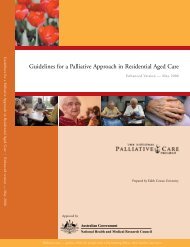Download - Palliative Care Australia
Download - Palliative Care Australia
Download - Palliative Care Australia
You also want an ePaper? Increase the reach of your titles
YUMPU automatically turns print PDFs into web optimized ePapers that Google loves.
PALLIATIVE CARE IN THE<br />
NORTHERN TERRITORY<br />
The Year 2005 marks an important time in the development of<br />
<strong>Palliative</strong> <strong>Care</strong> in the Northern Territory. These developments<br />
have been made possible through funding provided by both<br />
the Northern Territory Government and the <strong>Australia</strong>n<br />
Government Department of Health and Ageing.<br />
The first Director of <strong>Palliative</strong> Medicine for the Northern<br />
Territory, Dr Mark Boughey, commenced in March 2005.<br />
Dr Boughey, formally Director of <strong>Palliative</strong> <strong>Care</strong> at Royal<br />
Melbourne Hospital, is a well-credentialed and respected<br />
Specialist, whose significant experience will assist in<br />
fashioning the future development of palliative care<br />
services in the Northern Territory. His goal is to build on<br />
the last 10 years when palliative care has been available<br />
in the NT, with a view to improving access and broader<br />
equity in service provision. In May 2005, the Northern<br />
Territory <strong>Palliative</strong> <strong>Care</strong> Strategy for 2005-2009 was<br />
launched. This is another important milestone for the<br />
Territory.<br />
The first Hospice in Darwin opened on 26 August 2005.<br />
The Hospice provides people with a life-limiting illness,<br />
specialised care in a supportive and peaceful environment.<br />
The facility is a 12-bed purpose built unit, which is both<br />
functionally and culturally appropriate for the population it<br />
serves. It is co-located on the grounds of the Royal Darwin<br />
Hospital. In the first 2 months of operation, care was<br />
provided to 25 patients and their families.<br />
The Programme of Experience in a <strong>Palliative</strong> Approach<br />
(PEPA) has had a positive impact across the NT.<br />
Numerous primary service providers, including from<br />
rural and remote areas, have undertaken placements and<br />
participated in workshops. The result has been a workforce<br />
with increased knowledge and skills about palliative care<br />
and ultimately patients receive better care.<br />
Finally, the Indigenous Practice Principles Project aims<br />
to develop palliative care resources specific to the region<br />
and raise awareness of palliative care amongst Indigenous<br />
<strong>Australia</strong>ns. In the NT, the Project Officers have developed<br />
a companion guide to the Resource Kit that was produced<br />
by Wodonga TAFE, including artwork, photographs<br />
and case studies from the region. This companion guide<br />
is based upon the NT Aboriginal palliative care model.<br />
An animated PowerPoint presentation has also been<br />
developed that will be produced as a DVD. This resource<br />
will use music, photographs and video clips from the<br />
NT to educate and support health care providers in the<br />
provision of palliative care to Indigenous people.<br />
NATIONAL PALLIATIVE<br />
CARE PROGRAM<br />
The National <strong>Palliative</strong> <strong>Care</strong> Program has been reviewed<br />
and the current funding arrangements are in the final<br />
months of delivery. Everyone in the <strong>Palliative</strong> <strong>Care</strong> sector<br />
will have undoubtedly been involved in many activities<br />
and the significant achievements under this program.<br />
The following diagram illustrates the 6 priority area themes<br />
and the names of the project. For further information<br />
please visit www.health.gov.au/palliativecare<br />
PCA is eagerly looking forward to learning of the next<br />
funding arrangements and federal government policy<br />
priorities for palliative care in the Federal Budget this<br />
May and will keep you informed.<br />
PALLIATIVE CARE<br />
MEDICINES WORKING<br />
GROUP<br />
A workshop in February has established a team of people<br />
who will be working to increase the awareness of the<br />
medicines available for patients under the <strong>Palliative</strong> <strong>Care</strong><br />
Section of the Pharmaceutical Benefit Scheme (PBS)<br />
This special section of the PBS has recognised the different<br />
types and quantities of medicines that are required by<br />
palliative patients and has established a mechanism for<br />
doctors to access these medicines with additional cost<br />
subsidy benefits under the PBS.<br />
For example, a palliative patient is able to obtain an initial<br />
supply of Oxazepam 30mg x 50 tablets with 3 repeats,<br />
where anxiety is a problem and where consultation with<br />
a palliative care specialist or service has occurred. Their<br />
doctor contacts Medicare <strong>Australia</strong> for an authority to<br />
prescribe these quantities under the PBS. These new<br />
arrangements go a long way to reduce the cost and access<br />
issues for palliative patients.<br />
For a full list of medicines available under this scheme,<br />
please visit www.health.gov.au<br />
9

















